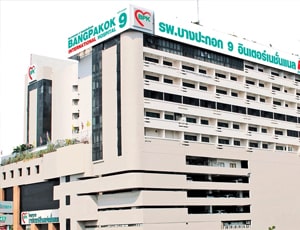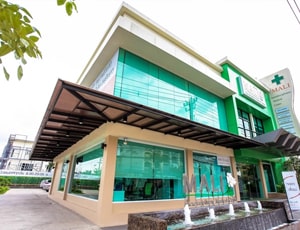Treatment cost

Bangpakok 9 International Hospital located in Bangkok, Thailand is accredited by JCI. Also listed below are some of the most prominent infrastructural details:


MALI Interdisciplinary Hospital located in Bangkok, Thailand is accredited by JCI. Also listed below are some of the most prominent infrastructural details:
ERCP procedure or Endoscopic Retrograde Cholangio-Pancreatography is an assessment as well as a procedure meant for rectifying problems in bile and pancreatic ducts. This is considered to be a very critical and life saving procedure involving an endoscope. Examination of critical areas needs to be done and rectification has to be done immediately with planned procedural steps.
An ERCP procedure is recommended in order to diagnose the status of bile ducts and the pancreas and if there are problems discovered during diagnosis then they are treated as well. The procedure is appropriate in order to do evaluation of symptoms that are suggestive of certain diseases prevalent in these organs. It is also used as a method of reconfirmation of abnormal results generated from ultrasound, CT scan or imaging tests and blood tests. If CT scan reveals abnormal mass or stones in these organs then ERCP is recommended.
The procedure can even be performed before and after a gall bladder surgery to help in the conducted operation’s performance in overall. If there are stones or tumours of both cancerous and non cancerous nature then they can be removed with the help of ERCP procedure from bile ducts and pancreas. If there have been any complications noted during gall bladder surgery then those can also be diagnosed with the help of this. Patients having any pancreatic disease or suspected disorder for them the ERCP method can suggest the requirement of surgery and the type of surgery that may be best for the treatment. In some cases pancreatic stones can be addressed and removed with the help of ERCP procedure.
Causes of the problems are mainly because of narrowing or blockage of the bile ducts and pancreatic duct. Gall stones are formed and they get stuck to the common bile duct thus requiring surgical interventions. Gall stones are usually formed of cholesterol in maximum cases while for 20% cases it is a result of calcium and pigments like bilirubin giving rise to stones. Other causes can be imbalance of diet and irregular lifestyle giving rise to infection. Alcohol drinking and fatty food consumption results in acute and chronic pancreatitis.
The way to know that you may be a patient requiring ERCP is:
The surgery technique makes use of a combination of luminal endoscopy compiled with fluoroscopic technique of imaging for the purpose of diagnosing and performs treatment of conditions that are associated with pancreatobiliary system. A side viewing instrument named the duodenoscope is utilized in the endoscopic portion that is made to travel through the esophagus and reach the stomach to access the duodenum’s second portion which is the part of small intestine.
In ERCP Sphincterotomy both fluoroscope and endoscope are employed and deep cannulation is done of the bile duct which is then followed by the sphincter of Oddi’s severance with electrocautery (heating).
Coming back to conventional ERCP, next the duodenal pailla is identified with the scope in the position discussed above and further inspection is carried out to find any abnormalities. The duodenal papilla is like a structural protrusion of the ampulla of Vater or the hepatopancreatic ampulla into the duodenal lumen. The ventral pancreatic duct and the common bile duct have a convergence point and that is this ampulla. So this ampulla behaves like a channel for draining pancreatic secretions and bile into the duodenum.
If contrast is injected into the pancreatic duct or if the pancreatic duct gets cannulated for quite a number of times then a temporary pancreatic duct stent placement or rectally administered NSAIDS (diclofenac or indomethacin) has to be considered. This has to be considered aiming to reduce the post-ERCP pancreatitis (PEP) risks. For PEP prophylaxis these two prevention modalities have shown some promise. Somatostatin, gabexate, heparin, nitroglycerin, allopurinol, steroids, octreotide and many more pharmacological agents have been studied but the results found were pretty disheartening.
In the second portion or segment of the duodenum, the minor duodenal papilla is also located and it behaves like an access point for the dorsal pancreatic duct. Dorsal pancreatic duct’s evaluation with ERCP is seldom performed and the ERCP indications are further discussed below:
With the side viewing endoscope the papilla is closely examined and then selective cannulation of the ventral pancreatic duct or common bile duct is performed. Once the cannulation of the selected duct is performed then either pancreatogram of the pancreatic duct or cholngiogram of common bile duct is obtained fluoroscopically with the injection of a material that is radiopaque contrasting in nature is done into the duct. These days ERCP is considered by surgeons like a therapeutic surgery where abnormalities that are observed via a fluoroscope can be particularly addressed by the methods of specialized accessories that can be passed via the endoscope’s working channel.
This procedure is a very advanced process and as a result of this serious complications tend to occur at a higher frequency than many other endoscopic processes. As per that special training and specialized devices and equipments are employed and for appropriate indications only this procedure is employed.
Indications that have been recorded for biliary diseases are given below:
Assessment of biliary obstruction and its treatment secondary to choledocholithiasis- if ascending cholangitis, worsening pancreatitis or worsening jaundice which are persistent are present then Precholecystectomy ERCP may be indicated.
Pancreatic malignancies can be diagnosed and the indications are:
There are also indications for ampullary diseases like
If a patient has the possibilities of developing post ERCP pancreatitis, then the process of diagnosis grows apparent within some hours after the procedure. The patient shall experience severe pain in abdomen back pain and nauseated feelings may be accompanied with vomiting sensation) and some amount of fever is also common. But then the observation period does not stretch beyond an hour after the ERCP procedure and is not enough time for checking for post ERCP Pancreatitis. For evolving post ERCP pancreatitis a two hour serum or urinary amylase level (>1000IU/L) is highly predictive if the patient can be kept under observation for a longer duration of time.
Another kind of procedure closely related to ERCP is the employment of miniature endoscopes that can be inserted via the operating channel of the duodenoscope. These can be directly inserted into the pancreatic or the bile duct. The interior side of the duct can be visualized and accordingly biopsies can be taken. There remain other possibilities for therapeutic interventions.
If in the common bile duct the bile duct stones are seen then the opening of the papilla will be made wider with the help of electrocautery or heating and then the stones are removed. For removal of stones sometimes a basket may be employed. If the narrowing of the bile duct is seen in the X-ray images then a small wire mesh or plastic tube which is a stent can be inserted to facilitate the bypassing of the blockage and allow the bile to move to the duodenum. Very mild pain after ERCP stent placement is felt.
ERCP complication chances are vastly reduced when performed by expert surgeons but still there persists some amount of complications like:
If by accident food or fluid is inhaled in the lungs then that can be a complication but it rarely occurs in patients who do not drink and eat several hours prior before the ERCP test.
As the sedative medications start wearing off the patient will be observed for further complications. The medicines administered causes drowsiness and there are difficulties observed in concentration so a patient will be advised to stay away from work.
The discomfort as most patients have expressed is a feeling of bloating which is a result of the introduction of air in the system during the time of examination but this problems can be quickly fixed. Some patients experience a throat sore which is very mild usually.
Most patient are in a condition to drink clear liquid after the test and in some scenario blood tests have to be conducted right after the ERCP procedure. If biopsy samples have been taken then they are required to be sent to the lab for further analysis right after the procedure.
Some amount of fatigue is very common during the recovery period and for abnormal temperatures observed one should immediately inform the clinical team to check for the conditions.
Ask your healthcare adviser for the best multiple options and choose the one that meets your expectations
The cost of ERCP (Diagnostic) in Bangkok may differ from one medical facility to the other. The ERCP (Diagnostic) package cost usually includes all the expenses related to pre and post surgery expenses of the patient. The comprehensive ERCP (Diagnostic) package cost includes the cost of investigations, surgery, medicines and consumables. Stay outside the package duration, port-operative complications and diagnosis of a new condition may further increase the ERCP (Diagnostic) cost in Bangkok.
There are several best hospitals for ERCP (Diagnostic) in Bangkok. The following are some of the most renowned hospitals for ERCP (Diagnostic) in Bangkok:
Upon discharge from the hospital after ERCP (Diagnostic) in Bangkok, the patients are advised to stay for about 3 days for recovery. This is important to ensure that the surgery was successful. During this time, control and follow-up tests take place to check for medical fitness.
Apart from the ERCP (Diagnostic) cost, the patient may have to pay for additional daily expenses such as for guest house after discharge and meals. These are the charges for daily meals and accommodation outside the hospital. The per day cost in this case may range from 25 USD.
There are about 2 Hospitals ERCP (Diagnostic) hospitals in Bangkok that are best known for their services. These hospitals have the required infrastructure and a decided ERCP (Diagnostic) unit where renal failure patients can be treated. Additionally, these hospitals are known to comply with the international standards as well as local legal requirements for the treatment of patients.